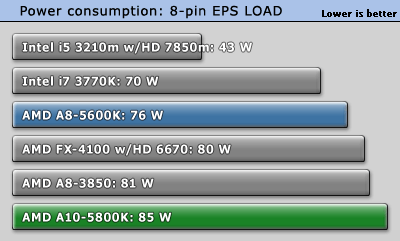 116
116
AMD A10-5800K and A8-5600K APUs for Socket FM2 Review
CPU Performance Results »Test System
| Test System | |
|---|---|
| CPU: | AMD A10-5800K 3.8 GHz(4.2 GHz Turbo), 4 MB Cache |
| Memory: | 16 GB DDR3 (4x 4 GB) Corsair Dominator Platinum CMD16GX3M4A2666C10 8 GB DDR3 (2x 4 GB) AMD Performance Edition Memory AP38G1869U2K |
| Cooling: | Corsair H100 |
| Motherboard: | Gigabyte F2A85X-UP4 AMD A85X, BIOS version: F2 |
| Video Card: | 2x Gigabyte WindForce Radeon HD 7950 3 GB |
| Harddisk: | Corsair ForceGT 60 GB SATA 6 Gb/s SSD(TEST) Western Digital WD500AAKS 500 GB SATA 3 Gb/s (DATA Corsair F60 60 GB SATA 3 Gb/s SSD(OS) Velocity SuperSpeed USB3.0 External Dock w/Corsair ForceGT(TEST) |
| Power Supply: | Silverstone Strider GOLD 750W |
| Case: | Antec P280 |
| Software: | Windows 7 64-bit SP1, ATI Catalyst 12.8 |
Power Consumption
We measure CPU power consumption since one of our first tasks is to truly verify system stability. I isolate the power coming through the 8-pin ATX connector using an in-line meter that provides voltage and current readings and total wattage passed through it. While this may not prove to isolate the CPU power draw in all instances, it does serve as a good indicator of board efficiency and effective VRM design. I also measure total system power consumption, allowing you to get an idea of how much power the board and installed devices draw.

Idle power consumption via the 8-pin CPU connector is quite decent. I added in some AMD Dual Graphics numbers here for comparison, but adding the VGA to the system had no effect on power draw through the 8-pin connector. Under load, the AMD A10-5800K can draw a fair bit of power with 85 W total. I noticed that the CPU frequency was pegged at 4.0 GHz on all cores under load and 4.2 GHz on a single core while the other three remained at 4.0 Ghz in idle. CPU speed dropped to 1400 MHz when the OS was truly inactive.


The full system numbers, on the other hand, were pretty impressive to me. The added discrete GPU only added a few watts at idle, but increased a fair bit to 135 W at load; however, seeing the FX chip match the APU's power numbers was a bit unexciting.
Jul 1st, 2025 03:13 CDT
change timezone
Latest GPU Drivers
New Forum Posts
- Recommend me a decent budget card :) (16)
- Will you buy a RTX 5090? (585)
- Do you use Linux? (666)
- Super-slow WiFi (2)
- R-T-B's PNY RTX 5080 OC Photo sideshow. (1)
- Question about Intel Optane SSDs (88)
- The Official Thermal Interface Material thread (1756)
- Your PC ATM (35476)
- Help with a gtx1050 mxm (1)
- [Request] GTX 1650 mobile DEV_1F99 SUBSYS_143E1025 VBIOS firmware (0)
Popular Reviews
- ASUS ROG Crosshair X870E Extreme Review
- Sapphire Radeon RX 9060 XT Pulse OC 16 GB Review - An Excellent Choice
- AVerMedia CamStream 4K Review
- Lexar NQ780 4 TB Review
- AMD Ryzen 7 9800X3D Review - The Best Gaming Processor
- Upcoming Hardware Launches 2025 (Updated May 2025)
- Sapphire Radeon RX 9070 XT Nitro+ Review - Beating NVIDIA
- AMD Ryzen 9 9950X3D Review - Great for Gaming and Productivity
- NVIDIA GeForce RTX 5060 8 GB Review
- Intel Core Ultra 7 265K Review
TPU on YouTube
Controversial News Posts
- Intel's Core Ultra 7 265K and 265KF CPUs Dip Below $250 (288)
- NVIDIA Grabs Market Share, AMD Loses Ground, and Intel Disappears in Latest dGPU Update (204)
- Some Intel Nova Lake CPUs Rumored to Challenge AMD's 3D V-Cache in Desktop Gaming (140)
- Microsoft Partners with AMD for Next-gen Xbox Hardware (105)
- NVIDIA Launches GeForce RTX 5050 for Desktops and Laptops, Starts at $249 (105)
- Intel "Nova Lake‑S" Series: Seven SKUs, Up to 52 Cores and 150 W TDP (100)
- NVIDIA GeForce RTX 5080 SUPER Could Feature 24 GB Memory, Increased Power Limits (97)
- Reviewers Bemused by Restrictive Sampling of RX 9060 XT 8 GB Cards (88)